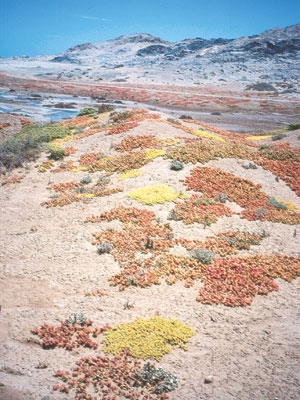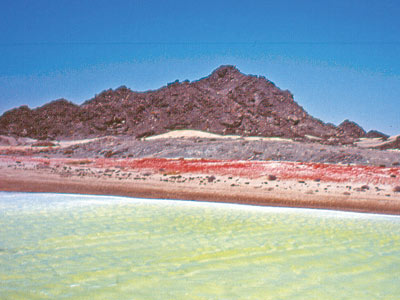Black Mountain and Bloodfinger
Lüdertiz is a very remote and rocky place. Nevertheless, this little town and its surroundings harbour many surprises. Most fascinating of these is the great variety of plants found on the peninsula south of Lüderitz.
After a rare good rainy season you may find large areas covered in a succulent, low growing plant known as "Blood finger" (Mesembryanthemum cryptanthum) [German: "Blutfinger"], for its stems and leaves can be green but are usually very red. The cylindrical stems can have a diameter of up to 10 mm and the rather inconspicuous flowers are white to pale yellow. A great number of different mesembs - as they are often referred to for easier pronunciation - occur in southern Namib. There are two explanations for the name, i.e. mesos (Gr) means 'in the middle', while embryon (Gr) = 'embryo' and anthemon (Gr) = 'flowers' refer to the central attachment of the seeds in the ovary; alternatively mesembria (Gr) = 'midday' refers to the flowers opening at midday, hence the German common name "Mittagsblüher" for this genus. The species name cryptanthum refers to the relatively small 'cryptic' flowers of this plant. Large bladder cells often found on these plants are a water-storage adaptation to their dry habitat.
Other plants of a different colour show up very well against the red background, here it is Drosanthemum luederitzii, whose leaves are also typically covered in glistening bladder cells. The Greek word "drosos" meaning 'dew' refers to this feature which is also found on the sepals, to which the Greek word "anthos" refers. This species is found as far north as Swakopmund.
In combination with several other plant species Blood finger splashes the forbidding desert landscape with colour. The stunning co-lour combination of this view is composed of a small greenish turquoise lake tinted by salts dissolved in the water. The opposite slope is covered in Bloodfinger. The so-called "Black Mountain" began its existence millions of years ago, when basaltic lava erupted onto what was then the bottom of a primeval ocean. Tectonic turmoil first buried these lava intrusions at great depths where intense heat and pressure metamorphosed them into black amphibolite, which was then thrust upwards far above sea level and eventually exposed by the forces of erosion.
The next two photos show the incredible diversity of plants to be found in this area. The plant with the swollen leaves is called Augea capensis, [Ger: "Dickfinger-Busch"; Afr: "kindervingertjies, kinderpieletjies"]. It is a very succulent yellow-green annual often found along road verges in sandy soil. The fleshy, waxy-looking leaves widen towards the tip ending in a minute sharp point. The 10-chambered fruit, fleshy at first, becomes brown and papery and splits open when dry. It is named Augea after Johann Andreas Auge, a German gardener and collector and capensis from the Cape of Good Hope.
Didelta carnosa has large yellow flowers and the broadly triangular flower bracts persist on the plant. It is known as Green Didelta [Afr. "perdeblom"] and occurs from Aus towards Lüderitz and down to the Orange River and eastwards from there to the Karas Mountains and Warmbad.
Many other plants are quite small and to really appreciate the multitude of different shapes you have to get out of your vehicle and bend down or crouch. You will be richly rewarded. Plants resembling miniature trees most likely belong to the genus Othonna, Gr for 'linen' or 'sail' probably referring to the bristles of the fruit which facilitate wind dispersal.
The central Namib has its lichen fields and so has the Lüderitz peninsula. The extent and composition of the lichen communities in Namibia is unique and much research into these organisms still needs to be done. Lichens form a symbiotic relationship between algae and fungi. The fungus attaches the plant to the substrate while the alga absorbs moisture - mostly from the atmosphere - and photosynthesises. The fungus also controls the shape of the lichen which can be upright and look similar to grey-green grass or it may encrust stones, rock faces and even other plants in bright yellow, orange or black.
Lichens are the first organisms to colonise bare habitats forming a crust, which protects the soil from wind and even water erosion and so prepares it for other more developed plant species. They can survive long periods of drought but are very vulnerable to being trod on or driven over. Even being pressed into the substrate by just a centimetre or two by the weight of a passing vehicle alters the angle at which they face the sun and the prevailing moisture laden wind and this may set them back by decades. This is one of the reasons why one should always stick to existing roads and even tread softly when walking among lichens. The growth of lichens is usually favoured by high humidity, cool temperatures and low light intensity, all of which are provided by the frequent occurrence of fog along Namibia's coast. They are very well adapted to absorbing available moisture very rapidly, but also dry out rapidly. They grow extremely slowly and their life span can be measured in tens and even hundreds of years. Because they are unable to withstand air pollution one of their uses is as indicators of pollution. Certain European lichens have been used in the manufacturing of perfumes, antibiotics and colouring agents, while in Namibia springbuck have been seen grazing on them. The Damara tern sometimes lays its single egg in a scrape among the lichens.
Read more about the fascinating flora and the geology of the vicinity of Lüderitz in "Wildflowers of the Southern Namib" by Coleen Mann-heimer, Gillian Maggs-Kölling, Herta Kolberg and Silke Rügheimer, ISBN 978-99916-0-878-5 and in "Namibia's Fascinating Geology" by Nicole Grünert.
After a rare good rainy season you may find large areas covered in a succulent, low growing plant known as "Blood finger" (Mesembryanthemum cryptanthum) [German: "Blutfinger"], for its stems and leaves can be green but are usually very red. The cylindrical stems can have a diameter of up to 10 mm and the rather inconspicuous flowers are white to pale yellow. A great number of different mesembs - as they are often referred to for easier pronunciation - occur in southern Namib. There are two explanations for the name, i.e. mesos (Gr) means 'in the middle', while embryon (Gr) = 'embryo' and anthemon (Gr) = 'flowers' refer to the central attachment of the seeds in the ovary; alternatively mesembria (Gr) = 'midday' refers to the flowers opening at midday, hence the German common name "Mittagsblüher" for this genus. The species name cryptanthum refers to the relatively small 'cryptic' flowers of this plant. Large bladder cells often found on these plants are a water-storage adaptation to their dry habitat.
Other plants of a different colour show up very well against the red background, here it is Drosanthemum luederitzii, whose leaves are also typically covered in glistening bladder cells. The Greek word "drosos" meaning 'dew' refers to this feature which is also found on the sepals, to which the Greek word "anthos" refers. This species is found as far north as Swakopmund.
In combination with several other plant species Blood finger splashes the forbidding desert landscape with colour. The stunning co-lour combination of this view is composed of a small greenish turquoise lake tinted by salts dissolved in the water. The opposite slope is covered in Bloodfinger. The so-called "Black Mountain" began its existence millions of years ago, when basaltic lava erupted onto what was then the bottom of a primeval ocean. Tectonic turmoil first buried these lava intrusions at great depths where intense heat and pressure metamorphosed them into black amphibolite, which was then thrust upwards far above sea level and eventually exposed by the forces of erosion.
The next two photos show the incredible diversity of plants to be found in this area. The plant with the swollen leaves is called Augea capensis, [Ger: "Dickfinger-Busch"; Afr: "kindervingertjies, kinderpieletjies"]. It is a very succulent yellow-green annual often found along road verges in sandy soil. The fleshy, waxy-looking leaves widen towards the tip ending in a minute sharp point. The 10-chambered fruit, fleshy at first, becomes brown and papery and splits open when dry. It is named Augea after Johann Andreas Auge, a German gardener and collector and capensis from the Cape of Good Hope.
Didelta carnosa has large yellow flowers and the broadly triangular flower bracts persist on the plant. It is known as Green Didelta [Afr. "perdeblom"] and occurs from Aus towards Lüderitz and down to the Orange River and eastwards from there to the Karas Mountains and Warmbad.
Many other plants are quite small and to really appreciate the multitude of different shapes you have to get out of your vehicle and bend down or crouch. You will be richly rewarded. Plants resembling miniature trees most likely belong to the genus Othonna, Gr for 'linen' or 'sail' probably referring to the bristles of the fruit which facilitate wind dispersal.
The central Namib has its lichen fields and so has the Lüderitz peninsula. The extent and composition of the lichen communities in Namibia is unique and much research into these organisms still needs to be done. Lichens form a symbiotic relationship between algae and fungi. The fungus attaches the plant to the substrate while the alga absorbs moisture - mostly from the atmosphere - and photosynthesises. The fungus also controls the shape of the lichen which can be upright and look similar to grey-green grass or it may encrust stones, rock faces and even other plants in bright yellow, orange or black.
Lichens are the first organisms to colonise bare habitats forming a crust, which protects the soil from wind and even water erosion and so prepares it for other more developed plant species. They can survive long periods of drought but are very vulnerable to being trod on or driven over. Even being pressed into the substrate by just a centimetre or two by the weight of a passing vehicle alters the angle at which they face the sun and the prevailing moisture laden wind and this may set them back by decades. This is one of the reasons why one should always stick to existing roads and even tread softly when walking among lichens. The growth of lichens is usually favoured by high humidity, cool temperatures and low light intensity, all of which are provided by the frequent occurrence of fog along Namibia's coast. They are very well adapted to absorbing available moisture very rapidly, but also dry out rapidly. They grow extremely slowly and their life span can be measured in tens and even hundreds of years. Because they are unable to withstand air pollution one of their uses is as indicators of pollution. Certain European lichens have been used in the manufacturing of perfumes, antibiotics and colouring agents, while in Namibia springbuck have been seen grazing on them. The Damara tern sometimes lays its single egg in a scrape among the lichens.
Read more about the fascinating flora and the geology of the vicinity of Lüderitz in "Wildflowers of the Southern Namib" by Coleen Mann-heimer, Gillian Maggs-Kölling, Herta Kolberg and Silke Rügheimer, ISBN 978-99916-0-878-5 and in "Namibia's Fascinating Geology" by Nicole Grünert.






Kommentar
Allgemeine Zeitung
Zu diesem Artikel wurden keine Kommentare hinterlassen